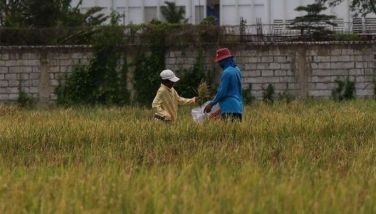Misguided priorities

I love eating corn, in particular the white ones. They may not taste as sweet as the yellow ones, but I find the kernels of the white variety softer and easier to digest.
However, they say that aside from the color, one major difference between yellow and white maize is that the beta carotene in yellow corn turns into vitamin A during digestion. The presence of carotenoids is responsible for the yellowness. This is the reason why they say that chicken that is fed with yellow maize grains produce eggs whose yolks have a more vibrant yellow to orange color.
I like my egg yolks on the orange side of the color spectrum.
But not all chicken are raised to produce eggs. Inspite of this, animal feed millers and mixers add yellow corn to the feeds because it is a rich source of carbohydrates for livestock.
Corn or maize is the second most-produced crop in the world, according to weforum.com. In the US, which is the world’s largest producer and exporter of corn and accounted for around 36 percent of exports last year, animal feed makes up nearly 40 percent of the country’s corn usage. Another 30 percent is used by the US for ethanol production.
Last year, China became the third-largest importer of US corn after Mexico and Brazil, and its import volumes are expected to be much higher this year.
The world’s biggest producers and exporters of corn are the US, China, and Brazil. While both the US and China are expecting record harvests, that of Brazil is expected to be down due to adverse weather conditions.
With demand rising from China and lower harvest in Brazil, it is expected that overall, corn supply will still not be enough and prices will remain high.
While we we bought imported yellow corn at around P16 a kilo last year, some are now buying anywhere from P20 to P30 per kilo.
Because of the higher cost, many small feed millers and mixers are suffering from huge losses, while some have already closed shop. The bigger ones are considering dropping corn as an input, and will instead develop a new feed formulation that will use an alternative energy grain to replace corn.
Unfortunately, even the alternatives like molasses are sourced from abroad. This means that the price of feed ingredients is still unstable and volatile.
We have always insisted on agricultural self-sufficiency as the only way out of this dilemma. As a small player in the world market, the Philippines has always been at the mercy of the global players who only supply to the export market what they do not need or what the bigger importing countries can spare.
Self-sufficiency should neither be just on paper, nor an election slogan. It needs a firm resolve on the part of our leaders to make self-sufficiency a priority. For decades, the agriculture department has tried, but continues to fail.
What do we do in the meantime? Our corn production is not enough, but our animal feed manufacturers need it. Instead of this, tariffs on corn imports are still high. Right now, we have a three-tiered tariff structure on corn: five percent for imports coming from ASEAN member-countries, 35 percent for imports forming part of what we call the minimum access volume, but coming from outside the region, and 50 percent for those outside the MAV.
According to the Philippine Association of Feed Millers (PAFMI), yellow corn accounts for 40 to 60 percent of animal feed formulation, while feeds make up 60 to 70 percent of the cost of producing poultry and meat products. No wonder, our prices of pork, chicken and eggs are that high.
While it is true that imports from ASEAN come in with a five percent tariff, unfortunately, there is not enough supply coming from the member-countries. So why don’t we just bring everything down to five percent, whether the corn imports are coming from the ASEAN or from the US, MAV or outside MAV?
Our government has always used protecting our farmers as an excuse for maintaining high tariffs. But this is not the only way. Given a viable domestic corn production program, our corn farmers will be able to produce enough to meet local demand and offer prices that can rival those coming from abroad.
Trust receipt violations
Trust receipt transactions are being used as a business device to help importers and merchants solve their financing problem.
In one case, our Supreme Court defined a trust receipt as a security transaction intended to aid in financing importers and retail dealers who do not have sufficient funds or resources to finance the importation or purchase of merchandise, and who may not be able to acquire credit except through utilization, as collateral, of the merchandise imported or purchased.
Upon the execution of a trust receipt, the entruster, say a bank, turns over the goods whose purchase it financed to the entrusted-buyer, who in turn has to sell or dispose of the goods. Once the goods are sold, the proceeds must be turned over to the entruster for the satisfaction of the amount owned by the entrustee.
Under the Trust Receipts Law (TRL), failure on the part of the entrustee to turn over the proceeds of the sale of the goods to the extent of the amount owed to the entruster or mere failure to return the goods if not sold, is punishable as estafa. And being malum prohibitum, there is no need to prove intent to defraud. If the violation is committed by a juridical entity like a corporation, the penalty of imprisonment is imposed upon the directors, officers or natural persons responsible for the crime.
In 2019, Philippine Veterans Bank filed estafa charges against the officers of Meihao Corp. for violation of the TRL. Unfortunately, after the information was filed, the Chinese owners of the medical supply company are still at large.
In its complaint, the bank claimed that the corporation applied for and was granted credit facilities with a limit of P110 million. After executing trust receipts in favor of PVB, the goods were released to Meihao by PVB, which were then sold by the company. However, the latter failed to turn over the proceeds of the sale of the goods subject of the trust receipts to the bank, and it did not turn over the goods to the bank, which PVB could have sold and the proceeds used to satisfy the debt. However, under the law, turning over the goods to the entruster will not satisfy the debt until the goods are sold and the proceeds applied, if enough, to pay the obligation under the trust receipt.
For failure to pay despite demand, PVB filed estafa charges against Jimmy Hao and Jamie Sheila Hao, president and vice president of Biñan, Laguna-based Meihao, which supplies medical equipment to various hospitals and medical institutions, for failure to turn over around P123 million inclusive of interests and penalties. Unfortunately, the two are nowhere to be found, leaving a huge debt with the bank.
For comments, email at [email protected]
- Latest
- Trending





























